
CCL: https://bit.ly/2DuliCV
We sincerely hope that you enjoy and appreciate this article about 4 Fabulous Marine Shrimp. These incredible creatures often go overlooked amid the teeming numbers of species in the oceans of the world. But they deserve their share of notice and appreciation.
These 4 Fabulous Marine Shrimp, of course, represent only a few of the related species found throughout the oceans and seas of the world. It’s our hope, however, that learning of these whets your appetite to learn more about them and their many relatives.
Pistol Shrimp
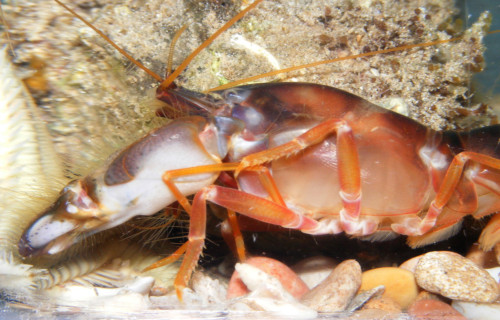
CCL: https://bit.ly/1iowB8m
Pistol Shrimp Facts
- Leading off this article about 4 Fabulous Marine Shrimp comes the small but deadly species known as the Pistol Shrimp.
- To the surprise of some, the term for the creature actually applies to many species. In fact, it serves for any of the amazing members of the Alpheidae family of shrimp. This family also currently contains an astounding 1,119 recognized species.
- That’s a truly astounding number. All members of this family, however, remain characterized by a single trait. That’s possessing asymmetrical claws. The larger claw in all of these species evolved as capable of generating a loud snapping sound.
- Its common name further derives from an incredibly unique ability it has. That’s due to the fact that, despite its diminutive stature, the animal remains one of the loudest creatures on earth. Its snapping can reach a volume of as much as 218 decibels.
- Not surprisingly, the dazzling creature has few natural predators, for understandable reasons. Like many other species, however, it now faces potential threats to its continued existence. The leading danger it faces consists of climate change.
- For the moment, though, relatively few types of Pistol Shrimp appear on the Red List of Threatened Species. This fortunate situation, as listed by the IUCN, remains precarious, however. That holds true for most of the species on earth, though.
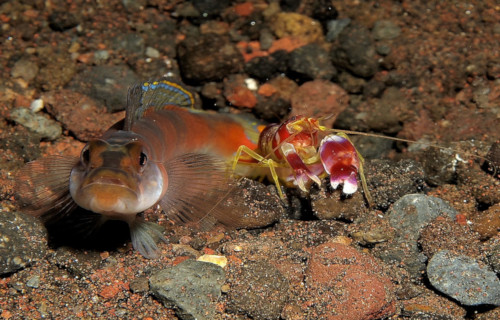
CCL: https://bit.ly/1ryPA8o
Pistol Shrimp Physical Description
The awesome Pistol Shrimp impresses based on factors other than sheer physical size. In fact, it typically attains an average length of only about 2 in (5 cm). The greatly oversized snapping claw, however, often grows as long as half the body length of the shrimp.
The design of the larger claw further remains entirely unique among known types of shrimp. That’s because it possesses a pistol-like component which comprised of two distinct parts. A special joint allows the hammer part to retract to a right angle position.
When released, this astounding appendage creates the characteristic snapping noise. The Pistol Shrimp also has yet another incredible evolutionary advantage. That’s due to the unexpected fact that this larger claw may appear on either of its arms.
While it usually develops on one arm only, if lost, it will regrow on the other arm. The arm that originally held the larger claw, meanwhile, will grow a new, smaller claw. The precise reason for this particular approach to replacement continues to elude researchers.
- Kingdom: Animalia
- Phylum: Arthropoda
- Class: Malacostraca
- Order: Decapoda
- Family: Alpheidae
Pistol Shrimp Distribution, Habitat, and Ecology
Given the number of different species of Pistol Shrimp, its range of overall distribution isn’t surprising. In point of fact, the animal appears virtually worldwide in its zone of habitation. Most of the various species, but not all, though, inhabit either tropical or temperate waters.
Those varieties that live in the warmer climates, meanwhile, display similar and precise preferences for their habitat. Most of these commonly make their homes in regions of coral reef. One remarkable species, however, actually lives only in freshwater caves.
Some species have also developed a symbiotic relationship with the goby fish. The two will even share the same protective burrow. The shrimp maintains the burrow. Having better eyesight, the goby fish watches for danger when the pair goes outside the burrow.
The method of sound generation is truly astonishing. The powerful claw opens so quickly and shuts with such velocity that it creates a cavitation bubble. This bubble expands outward rapidly. The outward pressure actually generates the powerful shock wave.
The Pistol Shrimp uses this to hunt for prey. The shock wave is brief, lasting only one millisecond. However, it is powerful enough to kill small fish, or even shatter glass. Groups of these shrimp in a feeding frenzy will actually interfere with the sonar of submarines.
Skeleton Shrimp

CCL: https://bit.ly/2Ac9wwj
Skeleton Shrimp Facts
- Next up among our choices for inclusion in this compendium of 4 Fabulous Marine Shrimp comes the unique Skeleton Shrimp.
- It must be pointed out that the descriptive term for this creature actually serves as the collective common name for an entire Family of arthropods. All members of the remarkable group, as the name suggest, evolved as purely marine species.
- It’s also a relatively large group, containing hundreds of separate species. The first official recognition of the Family as such occurred in the year 1814. This took place as a direct result of the work of the English zoologist, William Elford Leach.
- Given its astounding ability to virtually disappear into its surrounding environment, it also has other appropriate common names. Perhaps chief among these alternate, but highly descriptive names, is the applicable term of the ghost shrimp.
- Since the term of Skeleton Shrimp applies to so many different species, the various types naturally have differing statuses. Many of them, unfortunately, presently appear on the Red List of Threatened Species, routinely published by the IUCN.
- Although each species faces varying situations, dangers, and threats, most of them have some in common. One of these would be the danger posed by habitat loss, due to changing conditions in the oceans. The greatest, though, consists of climate change.
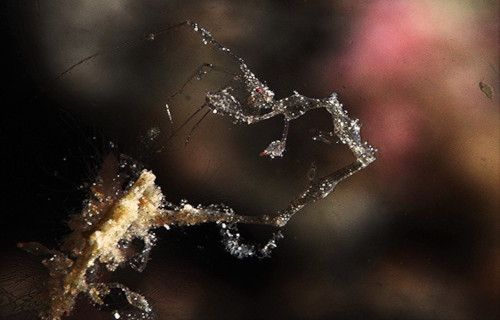
CCL: https://bit.ly/3dNuY9q
Skeleton Shrimp Physical Description
Since the term of Skeleton Shrimp refers to a vast number of different species, physical differences quite obviously exist. Despite that fact, however, many similarities between them naturally also exist, given the genetic relationship they each share.
One of these shared traits is the tendency of most of them to display a strong degree of the physiological trait of sexual dimorphism. In the case of the majority of members of this Family, that characteristic manifests itself in terms of sheer physical size.
The males of most species of these creatures attain a significantly greater size than their female counterparts. Aside from this tendency, the various forms also share one more defining trait. In fact, this characteristic serves as the source of the collective common name.
Each form of the amazing Skeleton Shrimp evolved as highly elongated and thin in shape. These further possess convoluted, twisting shapes to their bodies. Their color patterns, meanwhile, also differ between each of the members of the remarkably evolved Family.
- Kingdom: Animalia
- Phylum: Arthropoda
- Class: Malacostraca
- Order: Amphipoda
- Family: Caprellidae

CCL: https://bit.ly/3cJRI8Q
Skeleton Shrimp Distribution, Habitat, and Ecology
Because so many forms of Skeleton Shrimp exist, the Family as a whole possesses an extraordinary range of habitation. In fact, members of this remarkably evolved group fill all areas of virtually every ocean and sea on the planet with their numbers.
For the moment, the overall global population of this marvelous Amphipod appears to be spread around the planet roughly evenly. Due to this truly cosmopolitan distribution, they quite frequently encounter human presence, though most humans never notice them.
This mainly occurs due to the nature of the choice of habitat most of the species exhibit. The great majority prefer to live in the subtidal waters and low intertidal zones. More specifically, most elect to spend their time in areas of marine plants, mostly eelgrass.
A minor percentage of them, though, do inhabit the greater depths of the oceans. These, however, virtually never interact with humans. Wherever they appear, these creatures developed as omnivores, feeding on protozoans, diatoms, smaller amphipods, and detritus.
Most forms of Skeleton Shrimp further feed as ambush predators, much like praying mantises. Though not frequently preyed on themselves, a few species do consume them occasionally, The majority of their predators consist of shrimp, nudibranches, and jellyfish.
Mantis Shrimp

CCL: https://bit.ly/2DuliCV
Mantis Shrimp Facts
- The third species appearing in this compilation about 4 Fabulous Marine Shrimp is the dazzling Mantis Shrimp.
- Perhaps most amazingly, the term for it actually refers to any of the species in the suborder of Unipeltata. This contains a total of 451 separate species. All of these, however, evolved as highly aggressive species of marine crustaceans.
- The various members of this remarkable suborder all belong to one of two classifications. Uniquely, these classifications remain based on the manner in which the species attacks. Each species, therefore, gets classified as either a spearer or smasher.
- Quite surprisingly, perhaps, the animal often ranks as one of the most important predators in its given region. This holds true despite its relatively small size. Yet despite this, the amazing creature still remains comparatively poorly understood.
- For the moment, all species classified under the name of Mantis Shrimp appear to have stable populations. Fortunately, this trend appears to exist throughout the entirety of their natural ranges. This makes them more fortunate than some, though.
- Due to these facts, the IUCN currently has no listing for any of them on its Red List of Threatened Species. That could potentially change, since the creatures face increasing threats. The greatest of these, though, is the result of the effects of climate change.
Mantis Shrimp Physical Description
Quite understandably, given the large number of types of Mantis Shrimp, physical differences exist. Certain natural traits remain consistent among all recognized species in the fabulous suborder, however. That’s the very basis of the common grouping, in fact.
Since Nature loves variety, the various species display a comparatively wide variety of colors. These hues further range from a drab brown to bright, almost neon-like colors. The great majority of the different species, however, display the highly colorful patterns.
Sizes also naturally vary among the different forms of the fascinating Mantis Shrimp. Most of the forms also display various degrees of sexual dimorphism. In the case of these arthropods, this manifests itself in terms of males being larger than the females.
An overall average size, though, equals around 12 in (30 cm) in body length. Exceptional specimens do occasionally appear, however. A few of these attain measured lengths of as much as 15 in (38 cm). Only males have the highly oversized pair of claws, though.
- Kingdom: Animalia
- Phylum: Arthropoda
- Class: Malacostraca
- Order: Stomatopoda

CCL: https://bit.ly/1p2b8Ke
Mantis Shrimp Distribution, Habitat, and Ecology
Perhaps most notably, the types of the Mantis Shrimp have an impressive distribution. That’s because they inhabit nearly all temperate and tropical waters. The greatest concentration of both species and numbers appear between Hawaii and eastern Africa.
The two different classifications of Mantis Shrimp, distinctly, also prefer different types of habitat. The spearers prefer areas of soft sediment. The smashers, meanwhile, typically prefer either hard ground or regions of coral. Yet, both varieties create burrows.
Varying species of Mantis Shrimp also evolved different patterns of behavior. In point of fact, the arthropods live as either nocturnal, diurnal, or crepuscular. Unlike most crustaceans, it will hunt and pursue prey, if none comes within reach of its hiding place.
Though fewer in number, the smashers without doubt remain the most physically impressive group. This characteristic owes its existence to a particular ability, however. In proportion to their body size, they possess the fastest strike of any known creature on earth.
To put this in a clearer perspective, the effect is equivalent to arming the animals with miniature handguns. That’s due to the fact that these amazing shrimp remain capable of striking with a force and velocity roughly equal to that of delivered by a 22 caliber bullet.
The unfortunate prey, in fact, is actually struck twice with a single strike. The first remains the physical impact, itself a deadly strike. Secondly, however, comes the shock wave resulting from the velocity of the strike. The combined effect becomes devastating.
Harlequin Shrimp

CCL: https://bit.ly/1ryPA8o
Harlequin Shrimp Facts
- The last creature in this article about 4 Fabulous Marine Shrimp, the Harlequin Shrimp, lists there only due to random selection.
- Fascinatingly, the awesome form of shrimp remains a creature that not even the scientists can agree about. That’s because only some experts divide it into two distinct species. The majority, nevertheless, do consider it as only one species.
- This debate occurs due to an unusual fact, though. That’s the fact that specimens from its two distinct ranges have different color patterns. Other than that small difference, however, both groups remain physically indistinguishable.
- The noted French zoologist, Pierre Andre Latreille holds the distinction as the first researcher to officially recognize the creature. This he did in 1819. Whether it’s one species or two, scientists place it or them in the genus Hymenocera.
- The remarkable animal further evolved as extraordinarily sensitive to external stimuli. Any changes in temperature, water chemistry and salinity can therefore be detrimental to its health. Even high nitrate or copper levels can negatively affect it.
- As a result, the Harlequin Shrimp now faces an increased risk of extinction. Though several threats exist, the greatest peril comes from the effects of climate change. For the moment, though, the IUCN does not yet have a listing for this remarkable creature.
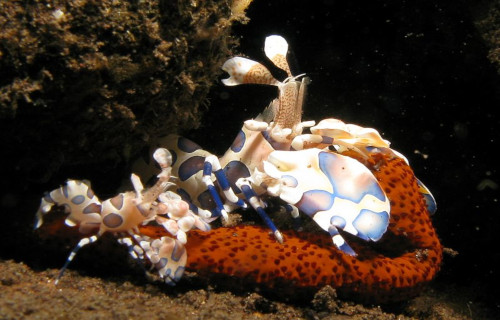
CCL: https://bit.ly/2DuliCV
Harlequin Shrimp Physical Description
Quite noticeably, the gorgeous Harlequin Shrimp most commonly presents a bright color pattern. This pattern of colors, furthermore, usually consists of a background of either cream color or an off-white. Some small, widely scattered spots also appear.
These small spots cause the large debate, however. In fact, these serve as the source of debate among scientists. That’s because, individuals in one region display red spots. Meanwhile, those inhabiting the other region presents purple spots. Thus the confusion.
Both groups appear exactly the same otherwise, in terms of overall physical appearance. More specifically, a typical adult individual attains a length of about 2 in (5 cm). It does, however, like many related species, display a small degree of the trait of sexual dimorphism.
In the particular case of the Harlequin Shrimp, the characteristic manifests itself in terms of sheer physical size. In point of fact, males of this remarkable animal reach greater lengths than females. The difference, though, remains extremely minor.
- Kingdom: Animalia
- Phylum: Arthropoda
- Class: Malacostraca
- Order: Decapoda
- Family: Hymenoceridae
- Genus: Hymenocera
- Species: H. picta
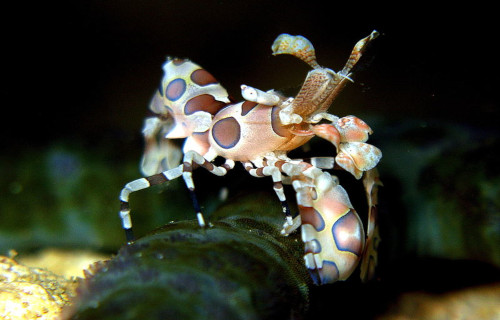
CCL: https://bit.ly/2K0yxJp
Harlequin Shrimp Distribution, Habitat, and Ecology
The awesome Harlequin Shrimp, whether it be one species or two, lives in two widely separated areas. These two regions remain extremely similar in terms of environment, however. Its habitat zones consist of the tropical portions of the Pacific and Indian Oceans.
The majority of individuals, however, live in one very specific region of the globe. To be more specific, the greatest concentration of numbers appear in the region around Hawaii. It’s currently unknown if this is a relatively new development, or a long-term pattern.
In all regions the animal appears in, though, it prefers a specific habitat type. This specific preference includes coral reefs. Even in this, though, it remains choosy. Most live below the intertidal zone. It also prefers a highly specific water temperature range.
It further feeds almost solely on only type of prey. That prey consists of various types of starfish. But, on rare occasions, it will consume sea urchins as well. The animal first turns the hapless victim onto its back, and then proceeds to feed on its feet and other soft tissues.
The Harlequin Shrimp itself, meanwhile, has few natural predators known to science. This fact occurs partly because the arthropod sometimes absorbs toxins from its prey. This therefore makes its own flesh distasteful, and sometimes deadly, to potential predators.

CCL: https://bit.ly/2DuliCV
4 Fabulous Marine Shrimp
We truly hope that you have thoroughly enjoyed reading and learning about these 4 Fabulous Marine Shrimp. Having done so, you no doubt now realize just how awesome these creatures are. Nature loves variety, and proves it perfectly with these ocean denizens.
Sadly, however, not all species in their part of the world enjoy the relative security that they do. Many now face the very real threat of extinction. It’s up to each and every one of us to do all that we can to ensure their continued survival, for their sake and our own.
Check out our other articles on 5 Remarkable Canadian Mammals, 4 Amazing New Guinea Species, 6 Extremely Rare Herbaceous Plants, 6 Mysterious Natural Phenomena

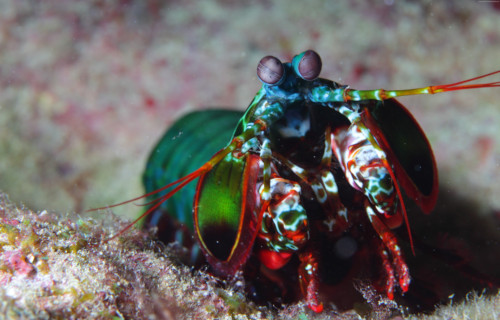









Leave a Reply